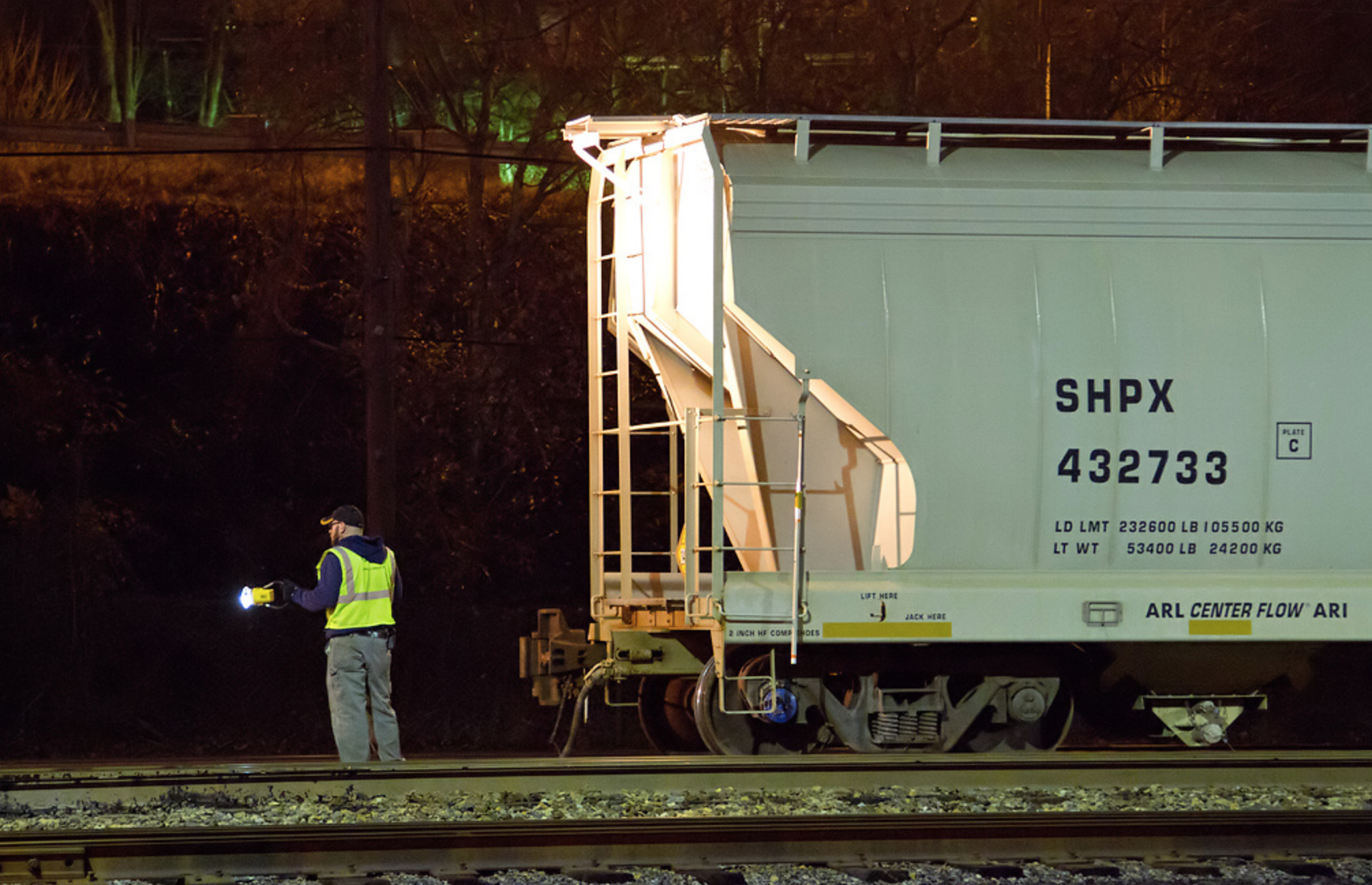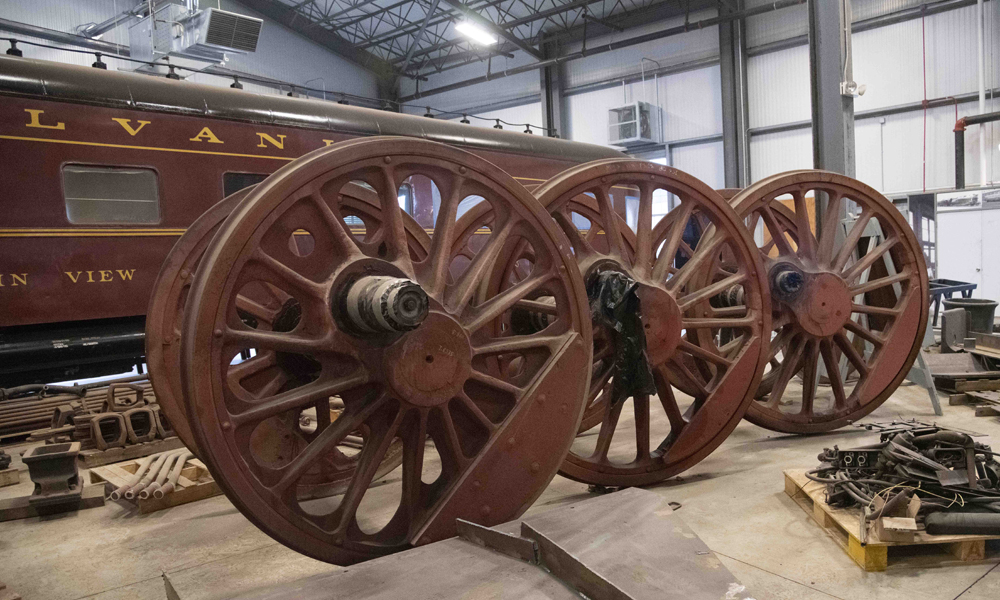On July 10, Trains News Wire acquired a copy of a CSX bulletin informing railroad crews that it would be prohibiting the use of brake sticks. The procedure, known as Safe Way Rule 2104.1, has been updated to inform train conductors and crew members that the use of a brake stick is prohibited for any task on CSX property.
Sources familiar with the matter say that brake sticks are often difficult to locate in sidings or at rail yards and that the time it takes to locate a brake stick may be perceived as inefficient to railroad management.
Getting rid of brake sticks is not the only rule amendment to take place under the leadership of CEO E. Hunter Harrison.
In late June, the railroad also informed its train and engine crews that it would be getting rid of the operational procedure known as three-step protection. In a notice sent to CSX railroaders on June 27, CSX announced that it had deleted the three-step protection term and its definition formerly governed under Operating Rule 205.6.
Three-step protection is a term used by several Class I, shortline, regional railroads to define when it is safe for a conductor or other employee to go between, behind, or under rail equipment. Three-step protection requires the locomotive engineer to apply the train’s automatic and independent brakes, place the locomotive’s reverser in the neutral position, and open the general field switch.
Now, conductors or other operators on CSX only have to receive a verbal radio transmission from the engineer that the train will not be moved until the inspection is complete.
Trains News Wire reached out to CSX for comment on the recent rule changes.
“As part of an ongoing comprehensive review of company operations, CSX continues to make changes across its network, including changes to operating rules, to improve safety, efficiency and service to customers,” CSX spokesman Rob Doolittle says. “As these operational changes are made, CSX managers are communicating with employees and conducting additional training in the field as necessary.”
CSX stock hit a 52-week high on Friday at $55.11 per share, ahead of the railroad’s second quarter 2017 earnings report scheduled for Tuesday, July 18.
The railroad is expected to share more information about on-time performance, dwell times, and average train speed improvements during Tuesday’s earnings call.















I’m employed as a locomotive engineer with a Class 1 railroad here in the U.S. Never once have I thought to myself, “boy, placing the engine into “3 point protection” is such a waste of time! You have to center the reverser, set the independent brake on the engine and the tough part is pushing down that little switch to deactivate the generator field!” I do this all the time every workday without giving it much thought. In fact, every time I’ve gone myself between two engines to perhaps MU them, I’m reminded on how that “3 point protection” is a little added safety comfort to get the job done when working between cars or engines.
The “Crazy 8s” (8888) runaway was in 2001. An event which was overshadowed by other, more egregious events.
How many years ago was when a CSX locomotive ran away from the yard in Toledo(IIRC), prompting a change in rules. In that case no one was harmed and the equipment corralled. But it was a close thing.
As reported in the “Business and Finance” section of this past weekend’s Wall Street Journal,CSX train crews (engineers and conductors) are now forbidden from taking “nap breaks” during their on-duty time, according to new company operating rules. This is in contrast to most other Class I carriers, except CN Rail and Canadian Pacific Railways, which EHH used to run.
Understand this is a complicated and complex situation but given the major issues related to irregular shifts and sleep-deprivation that the train crews constantly suffer with in a 24/7 railroad operations world, I can’t think that this is a positive move on CSX’s part (and the operating crews/unions will hate it).
Of course management’s answer is that they will now be running a “precision-scheduled” railroad (like the IC/CN and CP?) and therefore the CSX train crews will know exactly when they are expected to be on duty and can schedule their sleep times accordingly. Sure this will rationale will work out with no hiccups and detrimental impacts to the train crews whatsoever. Nothing ever goes wrong in the operational world of railroading (?) !
Too bad there can’t be a ‘Happy Medium” in all of this. I suspect employee morale among CSX train crews will only continue to decline (although I could be wrong?).
And again, 98% of the comments here are from neither shareholders nor employees. It shows. I am a shareholder and was until retirement a yard employee. I for one applaud the end of these dumb dumb dumb rules. Any engineer with a brain will not move power when your in between cars…that’s a given…unless your terminally stupid…brake sticks caused injuries to shoulders…and as anything on the railroad EVERYTHING causes injuries.
Using your head saves lives and one cannot make a rule for every EVERY situation but the previous administration tried their damndest.
Oh and almost to a man the employees I worked with appreciate the rule moves.
You are absolutely correct there Landon Rowell but I joined the 93% and 96% that voted to install him on the board and pay him the money. Sorta overwhelming majority isn’t it?
As to getting on and off moving equipment, in the 50’s on the PRR Elmira branch which extended from Williamsport, Pa. to Elmira, N.Y. because New York had a “full crew law” they had to add or drop off a brake man at the last block station in Pennsylvania. According to the special instructions in the employee time table the trains were to slow to 10 mph for him to get on or off. This was in the days of steam locomotives which generally lacked speedometers!
Not all CSX stock holders voted for EHH.
Drag up hills slow, slide down fast, tonnage first, safety last.
Sounds like Darth Hunter wants to roll back the clock to the era of roof-mounted running boards for brakemen, and link-and-pin couplers …
All you stock holders should be ashamed of yourselves. The great CSX has fallen, EHH is one big —–. I hope there comes a day when the bottom will fall out of CSX Stock, and all you stock holders that voted EHH in, get what you have coming. Changing work rules, Closing down hump yards, Closing down Shops. I feel for all you CSX workers on whats going to happen next.
Actually, I think there is a difference in switches. The “Gen Field Switch” is located on the operator console (along with the Fuel Pump and Control Switches), and causes the locomotive to load-fail if it is turned off. The “Generator Field Breaker” is located on the back panel in some older locomotives and is a separate control.
We let the engineer know we are going in “stop and hold” and he confirms, some guys still say 3 step but are being scolded by managers for saying that…
Also, what is the deal on Brake Sticks? That’s a new one on me. Is it the same a wheel skate?
With my very limited experience on a tourist RR, 3-step helped prevent human error from moving a consist unsafely while any of us were fouling equipment. I’m not really sure how removing 3-step for people doing ground work makes operations more efficient. Perhaps a CSX conductor or trainman could comment?
Mr. Norton, getting on and off any moving equipment is inherently more dangerous then dismounting/mounting stopped equipment, further more talk to the old heads about how bad there knees and hips and ankles are after a career of doing this! 3-Step has proven it worth in preventing serious accidents, operating fatalities are down for a reason! You don’t roll safety back, you move it forward.
I believe that would be GENERATOR field switch, a way to prevent the locomotive from moving by turning power off to the generator field. This is similar to putting a car in “neutral”; the engine can be reved, but no power is transferred to the traction motors. Why would it not be possible for any crew to have an understanding between themselves that when someone is on the ground, the train will be in “3-step” mode, without having to announce same? Its hard to imagine how the few seconds required to set up this protection could take very much money out of EHH’s pocket.
Mr. Krewer: Having a train stop to step off is really kinda sad, I rode with the local switch crew in college, These guys taught me, an honorary “cub,” how to step off a moving train! My grandfather was stepping off in his 70s. Its not a dangerous requirement and gets the work done quicker. That is what I believe is CSX’s idea here.
When safety takes time for productivity it takes time from the bottom line. CSX is a bottom line investor driven railroad where safety of the stock dividend, stock price, and return on investment are the only safety to be considered. Of course, those whose knowledge of railroading and safety don’t go beyond knocking the train over so as not to damage the Christmas presents under the tree wouldn’t understand the value of safety, now would they?
.
These operating rules changes are very much a return to the “old days” of railroading when whatever operating experience EHH and his merry band have was obtained. He has also reinstated the practice of getting on and off moving equipment at every railroad he’s been at.
He and his circle may see this as “more efficient” (read: faster) but fail to take into account that the railroaders of 50-60 years ago that worked under these rules learned these procedures by working directly under the tutelage and supervision of “old heads” for some time before they were put in charge of anything. I don’t think sending a guy with three month’s experience out into this situation by himself is even remotely comparable and may well be setting the employee up for failure.
I suppose the neon yellow safety vest will protect them….
Full disclosure: I am in charge of operating rules for one of the major operating rail museums in the U.S. and in my tenure I have added job briefings and three-point protection to our rulebook. Not the least bit period-authentic but considering the part-time volunteer nature of our operating personnel anything that keeps crews focused on safety and their task is just plain good sense.
Oh, and please leave those neon safety vests in your car.
Curious how many joints have been made, and how many hand brakes applied and released, by the folks promulgating these operating rule changes. My guess…not many. And where is the Brotherhood on these kinds of matters?
For those who don’t know a brake stick is a device that conductors use to tie hand brakes from that ground. They come in different lengths and they extend to about 5 to 6 ft .At 6 ft 5 inches im capable of tying and un tying most brakes from the ground without a brake stick but that’s also against the rules to do so without one. They make being a conductor a lot easier and safer so not real sure why csx is doing this unless the all mighty dollar is behind it. BE CAREFUL E HUNTER.
I’m at a loss for words on these changes. I guess safety is no longer a concern for HUNTER HARRISON as these changes are not in the best interest of safety but are suppose to help with efficiency. Aka profits. CSX get ready for the lawsuits. My class one issues us Break sticks to keep us off equipment as much as possible maybe they should do that instead of having a conductor have to go and find one in the middle of the night out on the middle of NOWHERE. IDIOT RUNNING THE SHOW AND CSX RIGHT INTO THE GROUND. You csx shareholders voted him in now it’s time to get rid of the thief. Because that’s what E HUNTER is.
Seen CSX crews use brake sticks in Tullahoma, Tennessee. Saves time by not having to climb the car to work brakes. Maybe the solution here is if a crewman wants to use such a device he has it on his person when reporting for duty.
Break Sticks?????